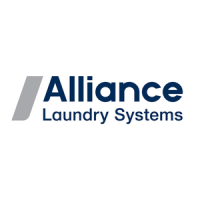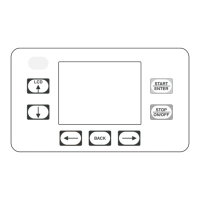






Do you have a question about the Alliance Laundry Systems UT075N and is the answer not in the manual?
| Brand | Alliance Laundry Systems |
|---|---|
| Model | UT075N |
| Category | Dryer |
| Type | Tumble Dryer |
| Capacity | 75 lb |
| Control Type | Microprocessor |
| Phase | 3 |
| Voltage | 208-240V |
Explains the meaning of DANGER, WARNING, CAUTION, IMPORTANT, and NOTE statements.
Provides essential safety precautions for operating the tumble dryer to prevent hazards.
Lists applicable models and directs users to the serial plate for specific model numbers.
Describes how to find the machine's serial plate for model and serial number information.
Describes the graphical, programmable computer control and its functions for the owner.
Explains how the control resumes or loses a cycle after a power outage.
Details the ability to communicate with a PDA or PC via an IrDA device for management.
Describes programming and auditing capabilities using a PC via a USB connection.
Explains how the control can communicate through a network for programming and diagnostics.
Covers collection and storage of audit information accessible via various communication methods.
Explains how the Error Status Indicator appears on the display when an error is recognized.
Details the nine keypads and their functions for operating the machine.
Explains the various modes the control operates in, such as Power-Up and Start modes.
Describes the mode the control enters upon powering up and what is displayed.
Explains how to pause and resume or terminate a running cycle.
Informs the user when a cycle was interrupted due to a power failure.
Details the control's state when ready to start a cycle, including display behavior.
Describes the mode when a cycle is actively running and how to pause or stop it.
Indicates when a cycle has finished and how the control transitions from this mode.
Explains the mode that checks essential machine components after power-up.
Describes how to enter and the purpose of the factory test mode for diagnostics.
Explains when the control enters this mode and that it displays all alarms and errors.
Details the mode entered when IR communication is in progress.
Allows manual programming, auditing, and diagnostics without external communication.
Allows users to advance machine cycles more quickly via network or IR.
Enables manual access to diagnostic functions without needing an external source.
Shows the current error on the display, prioritizing higher-level errors.
Describes the mode that periodically tumbles clothes after a cycle to prevent wrinkles.
Explains the mode that continues tumbling for an extended period after Anti-Wrinkle Mode.
Explains the step-by-step process of how the control runs a selected cycle.
Details how the control regulates temperature and time for this cycle type.
Explains how the control determines cycle time based on dryness level.
Describes how the control uses material type and moisture content for drying.
Provides step-by-step instructions on how to select and start a cycle.
Describes the menu used to select one of the available machine cycles.
Allows access to Cycle Info and Start options from the Cycle Selection Menu.
Displays attributes of a selected cycle, like time, temperature, and speed.
Shows prompts related to closing the loading or lint door to begin or resume a cycle.
Displays cycle name, status, temperature, and remaining time while the machine operates.
Provides a diagram illustrating the navigation within the System Menu.
Offers a diagram outlining the navigation paths for cycle-related menus.
Instructions for opening the service door on stacked dryer models.
Instructions for accessing the control panel on stand-alone dryer models.
The primary menu for accessing various control functions and settings.
Used to confirm or discard programming changes made in other menus.
Displays the current information and status of the running cycle.
Allows viewing programmed values for a cycle's individual steps while running.
Enables modification of cycle parameters like temperature and moisture during operation.
Shows the current state of control inputs and outputs for monitoring.
Allows manual programming by modifying existing or creating new cycles.
Guides users through modifying or copying existing cycles step-by-step.
Comprehensive list of global settings for language, time, cycles, and features.
Displays various audit parameters like cycle counts and run hours.
Displays detailed information about the machine, such as model and serial number.
Lists the last 25 errors and individual error audit counts.
Allows manipulation of machine outputs and monitoring of control inputs.
Allows running diagnostic test cycles for various machine components.
Provides options to perform individual manual diagnostic tests.
Lists daily maintenance checks for safety and proper operation.
Resets the control's global and cycle programming data to factory defaults.
Lists cycle numbers, names, types, material, reversing, temperature, and target moisture.
Lists cycle numbers, names, types, material, reversing, temperature, and dryness level or time.












